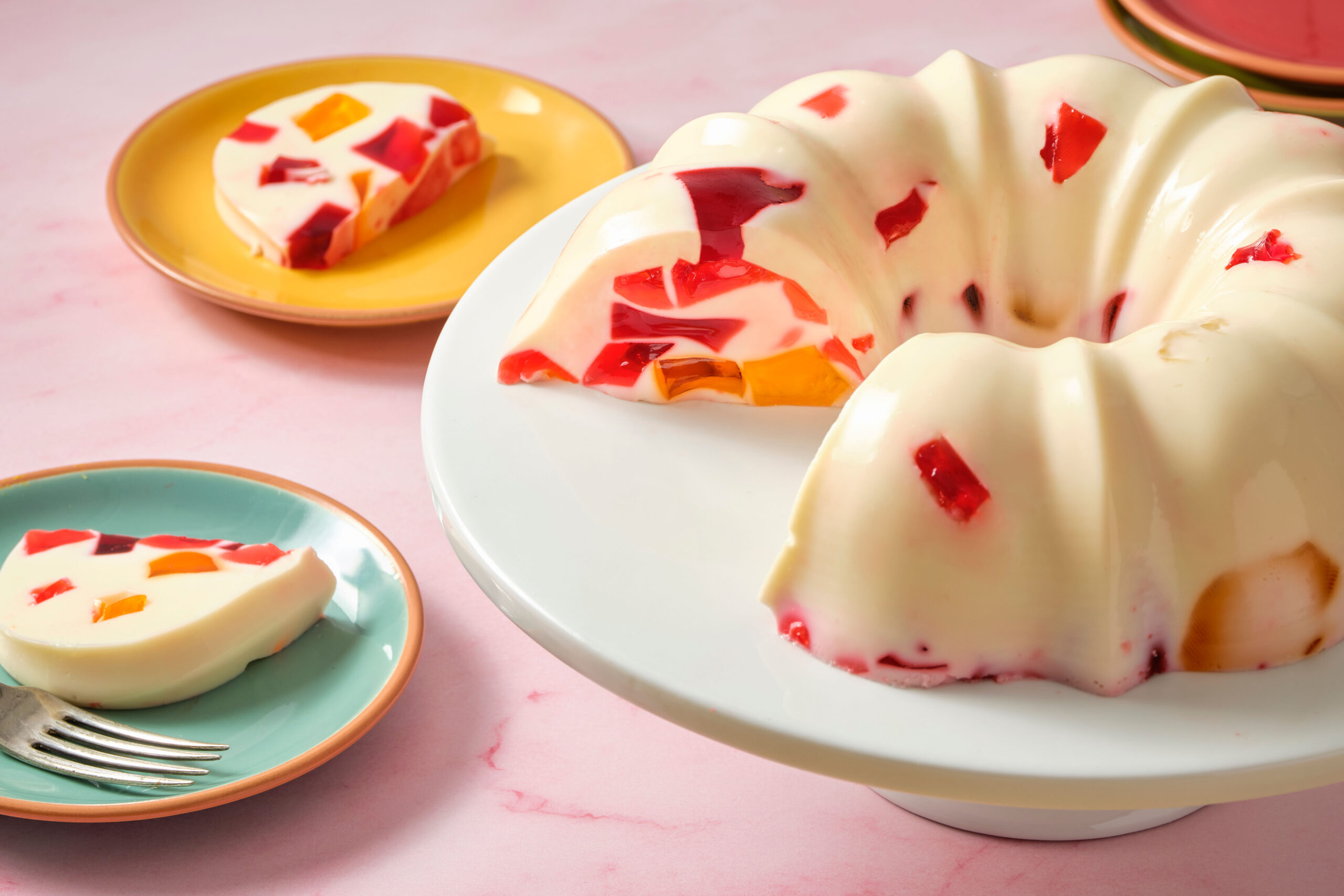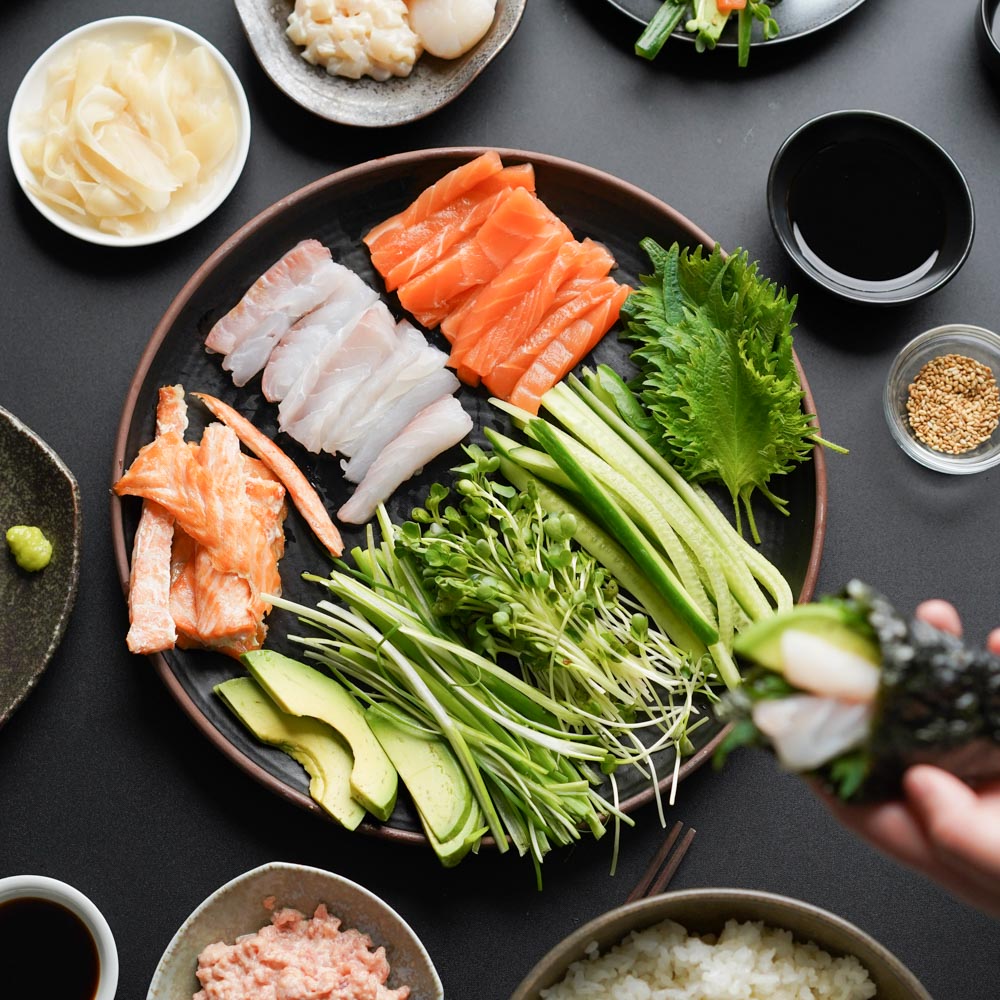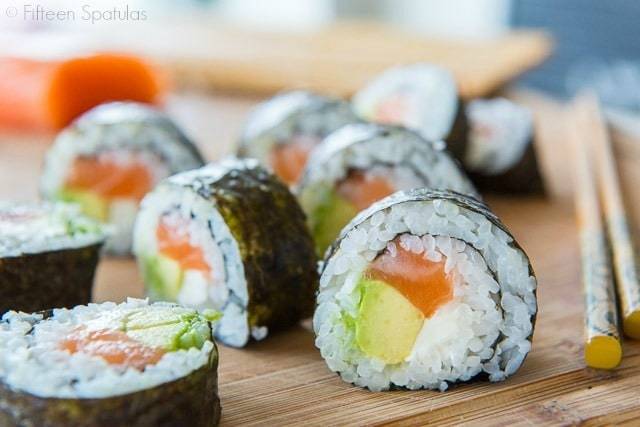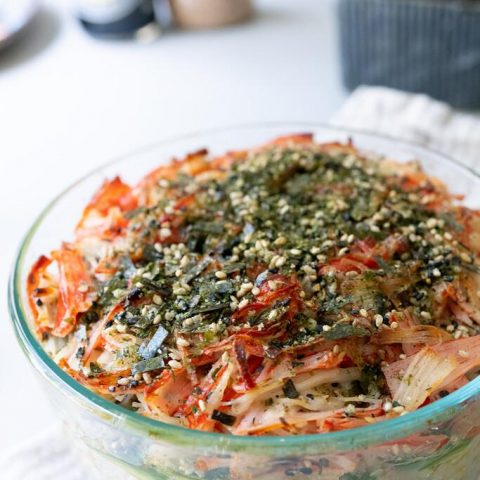Mosaic Sushi
4.9
(8)
Your folders
Your folders
Prep Time: 40 minutes
Total: 40 minutes
Servings: 3

Ingredients
Export 22 ingredients for grocery delivery
Instructions
Step 1
Gather all the ingredients. It‘s helpful to use a ruler to measure a precise checkerboard pattern for the Mosaic Sushi. Please use my topping ideas as just an example. I asked the fishmonger at the Japanese grocery store (Suruki Market in San Mateo) to slice the sashimi for me. If you buy a block of sashimi, slice it ⅛–¼ inch (3–6 mm) thick.
Step 2
To make the sushi vinegar (sushizu), combine 4 Tbsp rice vinegar (unseasoned), 2 Tbsp sugar, and 1 tsp Diamond Crystal kosher salt in a small saucepan and bring it to a boil over medium heat. Whisk until the sugar is completely dissolved. Alternatively, you can put the ingredients in a microwave-safe bowl and microwave for 1 minute or until the sugar is dissolved. Set aside to let it cool.
Step 3
If using a wooden sushi oke (also called hangiri), moisten it with running water and drain well. You can also use a baking sheet. Transfer 3½ cups cooked Japanese short-grain rice, freshly cooked, into the sushi oke. Spread out the hot rice evenly so it will cool faster.
Step 4
Drizzle the sushi vinegar over the rice. With a rice paddle, gently “slice” the rice at a 45-degree angle to incorporate the sushi vinegar mixture and separate the chunks of rice. Do not stir or mix the rice because the grains may break and the rice will become mushy. If your rice is freshly cooked, vigorously fan the rice with a paddle fan or another type of fan while using this slicing motion. This cools the rice and takes away the excess moisture. Fanning makes the rice shine and keeps it from becoming mushy. Gently flip the rice between slices. Repeat this process until the rice is cooled to the temperature of human skin.
Step 5
Sprinkle toasted white sesame seeds on top and gently distribute them throughout the sushi rice using a “slicing“ motion. Set aside.
Step 6
Place a sheet of parchment paper on the bottom of the container you‘re using. Here, I‘m using a 7½- x 7½-inch (19- x 19-cm) Japanese lacquered box called jubako (this traditional box is used for Osechi Ryori or as a lunch box). If you do not place parchment paper inside the container, the rice will stick to the bottom and it will be very hard to pick up the individual sushi pieces.
Step 7
Transfer the prepared sushi rice into the container. The measured rice (the whole 2 rice cooker cups you‘ve cooked) is just the perfect amount for this standard jubako size. With the rice paddle, evenly distribute the sushi rice to the corners and edges of the container, making sure the bed of sushi rice is level.
Step 8
Moisten a plastic dough scraper in water and use it to firmly press down the sushi rice. We don‘t want to overpress the rice and mash the grains, but the rice should be tightly packed so the sushi cubes hold their shape when you pick them up.
Step 9
Continue to press down the sushi rice with the dough scraper. Don‘t forget to moisten it so the rice doesn‘t stick to it. This type of sushi is called oshizushi or pressed sushi, so it is considered normal to press the rice grains.
Step 10
Now, cut the sushi rice into squares or cubes. Moisten the dough scraper with water and use it to makes a series of lengthwise slices through the bed of sushi rice across the width of the sushi box. The slices should be the same distance apart so you will have neat squares for the checkerboard pattern. Measure your sushi box so that your slices are equally distanced, about 1¼ inches (3 cm) to 1½ inches (4 cm) apart. For my 7½- x 7½-inch (19- x 19-cm) container, I cut the sushi rice about 1⅓ inches (3.5 cm) wide. Moisten the scraper after each slice to prevent sticking.
Step 11
Then, rotate the container 90 degrees, and again make lengthwise slices across the width of the box that are the same distance apart (1⅓ inches or 3.5 cm in my case) as the previous slices you made. You now have cubes about 1⅓ inches (3.5 cm) square. Set aside.
Step 12
Go over your slices a second time to separate and compress the sushi squares further; this will make it easier to remove the individual cubes when serving. Start by inserting the clean dough scraper that you’ve moistened with water into the first slice you made earlier. Move the scraper back and forth in a sawing motion along the entire length of the slice, ensuring a clear separation between the two sides. Next, press the scraper along the right side, firmly packing in the rice. Repeat along the left side. There will now be a gap of about 1 mm between the two sides. Move onto the next slice and repeat this “separate and compress” process. Moisten the scraper with water between slices and keep it clean of any rice grains or residue. Continue until you’ve finished all the lengthwise slices in that direction. Then, rotate the container 90 degrees and repeat with the remaining slices.
Step 13
Start cutting your topping ingredients into square pieces slightly larger than your sushi cubes; I cut mine about 3.6 cm wide for my 3.5-cm sushi cubes. Tip: For the best look, cut the topping ingredients slightly larger than the cube size so that the toppings cover the sushi rice completely and there are no visible gaps. For 1 Japanese or Persian cucumber, I use a vegetable peeler to slice it into paper-thin ribbons. Stack 3–4 ribbons and cut them into squares 3.6 x 3.6 cm wide.
Step 14
For 2 snap peas, insert the knife to open the pea pods. Cut them into squares 3.6 x 3.6 cm wide.
Step 15
For 1 okra (blanched), cut it into rounds ⅛ inch (3 mm) thick. For 1 Tamagoyaki (Sweet Rolled Omelette), cut it into ⅛-inch (3-mm) slices and further cut them into square pieces 3.6 cm wide.
Step 16
For the sashimi—3 slices sashimi-grade salmon, 3 slices sashimi-grade tuna, 6 pieces sashimi-grade shrimp (amaebi), and 2 pieces cooked shrimp—try your best to create a square shape. Here, I cut one slice of the salmon sashimi in half and layered it so it will look square.
Step 17
For 1 piece sashimi-grade scallop, slice it in half crosswise so each piece is thinner. For 2 pieces cooked surf clam (hokkigai), slice them in half and cut to shape the slices into squares.
Step 18
Decorate the Mosaic Sushi by placing a single type of topping onto each square. Make sure to maintain the straight lines of the checkerboard pattern and completely cover the sushi rice with the toppings.
Step 19
Consider the color, texture, and orientation of each ingredient as you place the toppings. For example, avoid putting similar-colored ingredients next to each other. For toppings like 2 Tbsp green peas or 4 Tbsp Ikura, simply place them kinome leavesto completely fill a square. Use a tiny garnish like ikura4 Tbsp Ikura, tobiko (flying fish roe), yuzu zest, slivers of 1 slice lemon, edible gold leaf flakes, and herbs like kinome leaves or chives to create dimension. I thinly sliced 1 red radish and formed the slices into a flower as a finishing touch.
Step 20
If you would like to make a vegan version of this recipe, please read the blog post for the ingredients I used for my vegan Mosaic Sushi and other topping ideas.
Step 21
Here is my finished vegan Mosaic Sushi.
Step 22
Enjoy Mosaic Sushi with soy sauce and wasabi for dipping. Serve green tea and pickled sushi ginger (gari) on the side.
Step 23
You can cover the leftovers with plastic and store in the refrigerator for 24 hours. For sashimi-grade fish, consume within 24-36 hours after purchasing.
Top similar recipes
Curated for youYour folders

 296 views
296 viewsMosaic Jell-O
patijinich.com
4.5
(6)
20 minutes
Your folders

 206 views
206 viewsTurkish Mosaic Cake Recipe
turkeysforlife.com
5 minutes
Your folders

 203 views
203 viewsMosaic Glazed Sugar Cookies
myfoodandfamily.com
42 minutes
Your folders

 148 views
148 viewsHow to Make Mosaic Substrates
madebybarb.com
Your folders

 1032 views
1032 viewsSushi Rolls (Maki Sushi - Hosomaki)
justonecookbook.com
4.7
(7)
Your folders

 335 views
335 viewsHand Roll Sushi (Temaki Sushi)
hungryhuy.com
5.0
(1)
20 minutes
Your folders

 65 views
65 viewsMake a Mosaic Pet Portrait with Dis...
madebybarb.com
Your folders

 433 views
433 viewsSushi - Wikipedia
en.wikipedia.org
Your folders

 579 views
579 viewsSushi rice
bbcgoodfood.com
15 minutes
Your folders

 241 views
241 viewsSushi timbales
taste.com.au
4.0
(3)
20 minutes
Your folders

 250 views
250 viewsSushi timbales
delicious.com.au
20 minutes
Your folders

 587 views
587 viewsOreo Sushi
oatslady.com
Your folders

 943 views
943 viewsHomemade Sushi
fifteenspatulas.com
Your folders

 955 views
955 viewsSushi Rice
norecipes.com
4.4
(10)
25 minutes
Your folders

 1167 views
1167 viewsInari Sushi
justonecookbook.com
4.3
(23)
Your folders

 730 views
730 viewsSushi Rice
favfamilyrecipes.com
4.9
(13)
30 minutes
Your folders

 536 views
536 viewsSushi rice
taste.com.au
4.7
(7)
15 minutes
Your folders

 339 views
339 viewsSushi Bake
onolicioushawaii.com
4.5
(133)
15 minutes
Your folders

 179 views
179 viewsSteak Sushi
cookbycolornutrition.com
10 minutes